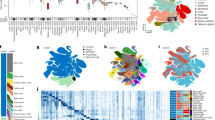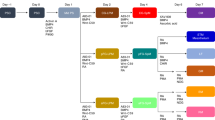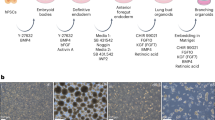Abstract
Defining the precise regionalization of specified definitive endoderm progenitors is critical for understanding the mechanisms underlying the generation and regeneration of respiratory and digestive organs, yet the patterning of endoderm progenitors remains unresolved, particularly in humans. We performed single-cell RNA sequencing on endoderm cells during the early somitogenesis stages in mice and humans. We developed molecular criteria to define four major endoderm regions (foregut, lip of anterior intestinal portal, midgut, and hindgut) and their developmental pathways. We identified the cell subpopulations in each region and their spatial distributions and characterized key molecular features along the body axes. Dorsal and ventral pancreatic progenitors appear to originate from the midgut population and follow distinct pathways to develop into an identical cell type. Finally, we described the generally conserved endoderm patterning in humans and clear differences in dorsal cell distribution between species. Our study comprehensively defines single-cell endoderm patterning and provides novel insights into the spatiotemporal process that drives establishment of early endoderm domains.
Similar content being viewed by others
Log in or create a free account to read this content
Gain free access to this article, as well as selected content from this journal and more on nature.com
or
Data availability
The RNA-seq data from this publication have been deposited in the Genome Sequence Archive (GSA) and assigned the identifiers CRA003104 and HRA000280.
References
Takebe, T. & Wells, J. M. Organoids by design. Science 364, 956–959 (2019).
Zorn, A. M. & Wells, J. M. Vertebrate endoderm development and organ formation. Annu. Rev. Cell Dev. Biol. 25, 221–251 (2009).
Grapin-Botton, A. & Melton, D. A. Endoderm development: from patterning to organogenesis. Trends Genet. 16, 124–130 (2000).
Lewis, S. L. & Tam, P. P. Definitive endoderm of the mouse embryo: formation, cell fates, and morphogenetic function. Dev. Dyn. 235, 2315–2329 (2006).
Peng, G. et al. Spatial transcriptome for the molecular annotation of lineage fates and cell identity in mid-gastrula mouse embryo. Dev. Cell 36, 681–697 (2016).
Peng, G. et al. Molecular architecture of lineage allocation and tissue organization in early mouse embryo. Nature 572, 528–532 (2019).
Kraus, M. R. & Grapin-Botton, A. Patterning and shaping the endoderm in vivo and in culture. Curr. Opin. Genet. Dev. 22, 347–353 (2012).
Guiu, J. & Jensen, K. B. From definitive endoderm to gut — a process of growth and maturation. Stem Cells Dev 24, 1972–1983 (2015).
Tam, P. P., Khoo, P. L., Wong, N., Tsang, T. E. & Behringer, R. R. Regionalization of cell fates and cell movement in the endoderm of the mouse gastrula and the impact of loss of Lhx1(Lim1) function. Dev. Biol. 274, 171–187 (2004).
Tam, P. P. & Loebel, D. A. Gene function in mouse embryogenesis: get set for gastrulation. Nat. Rev. Genet. 8, 368–381 (2007).
Dessimoz, J., Opoka, R., Kordich, J. J., Grapin-Botton, A. & Wells, J. M. FGF signaling is necessary for establishing gut tube domains along the anterior-posterior axis in vivo. Mech. Dev. 123, 42–55 (2006).
McLin, V. A., Rankin, S. A. & Zorn, A. M. Repression of Wnt/β-catenin signaling in the anterior endoderm is essential for liver and pancreas development. Development 134, 2207–2217 (2007).
Kumar, M., Jordan, N., Melton, D. & Grapin-Botton, A. Signals from lateral plate mesoderm instruct endoderm toward a pancreatic fate. Dev. Biol. 259, 109–122 (2003).
Roberts, D. J. et al. Sonic hedgehog is an endodermal signal inducing Bmp-4 and Hox genes during induction and regionalization of the chick hindgut. Development 121, 3163–3174 (1995).
Tiso, N., Filippi, A., Pauls, S., Bortolussi, M. & Argenton, F. BMP signalling regulates anteroposterior endoderm patterning in zebrafish. Mech. Dev. 118, 29–37 (2002).
Chen, Y. et al. Retinoic acid signaling is essential for pancreas development and promotes endocrine at the expense of exocrine cell differentiation in Xenopus. Dev. Biol. 271, 144–160 (2004).
Wells, J. M. & Melton, D. A. Early mouse endoderm is patterned by soluble factors from adjacent germ layers. Development 127, 1563–1572 (2000).
Chawengsaksophak, K., de Graaff, W., Rossant, J., Deschamps, J. & Beck, F. Cdx2 is essential for axial elongation in mouse development. Proc. Natl. Acad. Sci. USA 101, 7641–7645 (2004).
Dufort, D., Schwartz, L., Harpal, K. & Rossant, J. The transcription factor HNF3β is required in visceral endoderm for normal primitive streak morphogenesis. Development 125, 3015–3025 (1998).
Kinkel, M. D., Eames, S. C., Alonzo, M. R. & Prince, V. E. Cdx4 is required in the endoderm to localize the pancreas and limit β-cell number. Development 135, 919–929 (2008).
Martinez Barbera, J. P. et al. The homeobox gene Hex is required in definitive endodermal tissues for normal forebrain, liver and thyroid formation. Development 127, 2433–2445 (2000).
Zaret, K. S. Genetic programming of liver and pancreas progenitors: lessons for stem-cell differentiation. Nat. Rev. Genet. 9, 329–340 (2008).
Li, L. C. et al. Single-cell transcriptomic analyses reveal distinct dorsal/ventral pancreatic programs. EMBO Rep. 19, e46148 (2018).
Jennings, R. E. et al. Laser capture and deep sequencing reveals the transcriptomic programmes regulating the onset of pancreas and liver differentiation in human embryos. Stem Cell Rep. 9, 1387–1394 (2017).
Rodriguez-Seguel, E. et al. Mutually exclusive signaling signatures define the hepatic and pancreatic progenitor cell lineage divergence. Genes Dev. 27, 1932–1946 (2013).
Tremblay, K. D. & Zaret, K. S. Distinct populations of endoderm cells converge to generate the embryonic liver bud and ventral foregut tissues. Dev. Biol. 280, 87–99 (2005).
Angelo, J. R., Guerrero-Zayas, M. I. & Tremblay, K. D. A fate map of the murine pancreas buds reveals a multipotent ventral foregut organ progenitor. PLoS One 7, e40707 (2012).
Chung, W. S., Shin, C. H. & Stainier, D. Y. Bmp2 signaling regulates the hepatic versus pancreatic fate decision. Dev. Cell 15, 738–748 (2008).
McCauley, H. A. & Wells, J. M. Pluripotent stem cell-derived organoids: using principles of developmental biology to grow human tissues in a dish. Development 144, 958–962 (2017).
Picelli, S. et al. Full-length RNA-seq from single cells using Smart-seq2. Nat. Protoc. 9, 171–181 (2014).
Nowotschin, S. et al. The emergent landscape of the mouse gut endoderm at single-cell resolution. Nature 569, 361–367 (2019).
Pijuan-Sala, B. et al. A single-cell molecular map of mouse gastrulation and early organogenesis. Nature 566, 490–495 (2019).
Wang, X., He, Y., Zhang, Q., Ren, X. & Zhang, Z. Direct comparative analysis of 10X Genomics chromium and Smart-seq2. bioRxiv https://doi.org/10.1101/615013 (2019).
Ding, J. et al. Systematic comparison of single-cell and single-nucleus RNA-sequencing methods. Nat. Biotechnol. 38, 737–746 (2020).
Li, L. et al. Single-cell RNA-seq analysis maps development of human germline cells and gonadal niche interactions. Cell Stem Cell 20, 858–873 (2017).
Hou, J. et al. A systematic screen for genes expressed in definitive endoderm by Serial Analysis of Gene Expression (SAGE). BMC Dev. Biol. 7, 92 (2007).
Sherwood, R. I. et al. Prospective isolation and global gene expression analysis of definitive and visceral endoderm. Dev. Biol. 304, 541–555 (2007).
Tasic, B. et al. Adult mouse cortical cell taxonomy revealed by single cell transcriptomics. Nat. Neurosci. 19, 335–346 (2016).
Li, H. et al. Classifying Drosophila olfactory projection neuron subtypes by single-cell RNA sequencing. Cell 171, 1206–1220 (2017).
Haghverdi, L., Lun, A. T. L., Morgan, M. D. & Marioni, J. C. Batch effects in single-cell RNA-sequencing data are corrected by matching mutual nearest neighbors. Nat. Biotechnol. 36, 421–427 (2018).
Kanton, S. et al. Organoid single-cell genomic atlas uncovers human-specific features of brain development. Nature 574, 418–422 (2019).
Hebrok, M., Kim, S. K. & Melton, D. A. Notochord repression of endodermal Sonic hedgehog permits pancreas development. Genes Dev. 12, 1705–1713 (1998).
Miki, R. et al. Fate maps of ventral and dorsal pancreatic progenitor cells in early somite stage mouse embryos. Mech. Dev. 128, 597–609 (2012).
Hastie, T. & Stuetzle, W. Principal curves. J. Am. Stat. Assoc. 84, 502–516 (1989).
Stafford, D. & Prince, V. E. Retinoic acid signaling is required for a critical early step in zebrafish pancreatic development. Curr. Biol. 12, 1215–1220 (2002).
Zorn, A. M. StemBook (IOS Press, Amsterdam, 2008).
Jung, J., Zheng, M., Goldfarb, M. & Zaret, K. S. Initiation of mammalian liver development from endoderm by fibroblast growth factors. Science 284, 1998–2003 (1999).
Calmont, A. et al. An FGF response pathway that mediates hepatic gene induction in embryonic endoderm cells. Dev. Cell 11, 339–348 (2006).
Zhang, N. et al. Biodegradable polymeric micelles encapsulated JK184 suppress tumor growth through inhibiting Hedgehog signaling pathway. Nanoscale 7, 2609–2624 (2015).
La Manno, G. et al. RNA velocity of single cells. Nature 560, 494–498 (2018).
Wang, D. et al. Gene expression profile analysis in epilepsy by using the partial least squares method. Sci. World J. 2014, 731091 (2014).
Franklin, V. et al. Regionalisation of the endoderm progenitors and morphogenesis of the gut portals of the mouse embryo. Mech. Dev. 125, 587–600 (2008).
Pan, F. C. & Wright, C. Pancreas organogenesis: from bud to plexus to gland. Dev. Dyn. 240, 530–565 (2011).
McDole, K. et al. In toto imaging and reconstruction of post-implantation mouse development at the single-cell level. Cell 175, 859–876 (2018).
Matsushita, S. Fate mapping study of the endoderm of the 1.5-day-old chick embryo. Rouxs. Arch. Dev. Biol. 205, 225–231 (1996).
Gu, G. et al. Global expression analysis of gene regulatory pathways during endocrine pancreatic development. Development 131, 165–179 (2004).
Butler, A., Hoffman, P., Smibert, P., Papalexi, E. & Satija, R. Integrating single-cell transcriptomic data across different conditions, technologies, and species. Nat. Biotechnol. 36, 411–420 (2018).
de Bakker, B. S. et al. An interactive three-dimensional digital atlas and quantitative database of human development. Science 354, aag0053 (2016).
Grapin-Botton, A. StemBook (IOS Press, Amsterdam, 2008).
Kimura, S. et al. The T/ebp null mouse: thyroid-specific enhancer-binding protein is essential for the organogenesis of the thyroid, lung, ventral forebrain, and pituitary. Genes Dev. 10, 60–69 (1996).
Spence, J. R. et al. Sox17 regulates organ lineage segregation of ventral foregut progenitor cells. Dev. Cell 17, 62–74 (2009).
Kirby, M. L. et al. Hensen’s node gives rise to the ventral midline of the foregut: implications for organizing head and heart development. Dev. Biol. 253, 175–188 (2003).
Piette, D., Hendrickx, M., Willems, E., Kemp, C. R. & Leyns, L. An optimized procedure for whole-mount in situ hybridization on mouse embryos and embryoid bodies. Nat. Protoc. 3, 1194–1201 (2008).
Gross-Thebing, T., Paksa, A. & Raz, E. Simultaneous high-resolution detection of multiple transcripts combined with localization of proteins in whole-mount embryos. BMC Biol. 12, 55 (2014).
de Soysa, T. Y. et al. Single-cell analysis of cardiogenesis reveals basis for organ-level developmental defects. Nature 572, 120–124 (2019).
Takahashi, M., Makino, S., Kikkawa, T. & Osumi, N. Preparation of rat serum suitable for mammalian whole embryo culture. J. Vis. Exp. 90, e51969 (2014).
Kim, D. et al. TopHat2: accurate alignment of transcriptomes in the presence of insertions, deletions and gene fusions. Genome Biol. 14, R36 (2013).
Anders, S., Pyl, P. T. & Huber, W. HTSeq — a Python framework to work with high-throughput sequencing data. Bioinformatics 31, 166–169 (2015).
Liao, Y., Smyth, G. K. & Shi, W. featureCounts: an efficient general purpose program for assigning sequence reads to genomic features. Bioinformatics 30, 923–930 (2014).
Li, H. et al. The sequence alignment/map format and SAMtools. Bioinformatics 25, 2078–2079 (2009).
Smith, T., Heger, A. & Sudbery, I. UMI-tools: modeling sequencing errors in Unique Molecular Identifiers to improve quantification accuracy. Genome Res. 27, 491–499 (2017).
Wagner, G. P., Kin, K. & Lynch, V. J. Measurement of mRNA abundance using RNA-seq data: RPKM measure is inconsistent among samples. Theory Biosci. 131, 281–285 (2012).
Kanehisa, M. & Goto, S. KEGG: kyoto encyclopedia of genes and genomes. Nucleic Acids Res. 28, 27–30 (2000).
Croft, D. et al. Reactome: a database of reactions, pathways and biological processes. Nucleic Acids Res. 39, D691–D697 (2011).
Akima, H. Algorithm 761: scattered-data surface fitting that has the accuracy of a cubic polynomial. ACM Trans. Math. Softw. 22, 362–371 (1996).
Acknowledgements
We thank Drs. Ken Zaret, Chris Wright, and Erfei Bi for their critical advice; Drs. Genji Qin and Peng Du for assistance with imaging; Drs. Jing Zhang and Yi Wang for assistance with human embryo collection; members of the Xu laboratory for advice and comments; Ms. Yanzhu Yue and Dr. Aibin He for assistance with the rat serum preparation and tissue culture; and the Peking-Tsinghua Center for Life Science Computing Platform. We thank the flow cytometry Core at National Center for Protein Sciences at Peking University, particularly Ms. Fei Wang and Ms. Yinghua Guo for technical help, and Mr. Ming Du from the Core Facility of the School of Life Sciences for drawing schematics. This work was supported by the National Key R&D Program of China (2019YFA0801500), the National Basic Research Program of China (2015CB942800), the National Natural Science Foundation of China (31521004, 31471358, and 31522036), and funding from Peking-Tsinghua Center for Life Sciences.
Author information
Authors and Affiliations
Contributions
C.-R.X. conceived the project; C.-R.X., L.-C.L., and X.W. designed the study; L.-C.L., Z.-R.X., Y.-C.W, Y.F., Liu Y., and Li Y. performed the experiments; L.-C.L., X.W., W.-L.Q., Z.-R.X., X.-X.Y., J.G. and C.-R.X. analyzed the data; L.-C.L., X.W., X.-X.Y., and C.-R.X. wrote the manuscript.
Corresponding author
Ethics declarations
Competing interests
The authors declare no competing interests.
Supplementary information
Rights and permissions
About this article
Cite this article
Li, LC., Wang, X., Xu, ZR. et al. Single-cell patterning and axis characterization in the murine and human definitive endoderm. Cell Res 31, 326–344 (2021). https://doi.org/10.1038/s41422-020-00426-0
Received:
Accepted:
Published:
Issue date:
DOI: https://doi.org/10.1038/s41422-020-00426-0
This article is cited by
-
PAX1 represses canonical Wnt signaling pathway and plays dual roles during endoderm differentiation
Cell Communication and Signaling (2024)
-
A statistical method for quantifying progenitor cells reveals incipient cell fate commitments
Nature Methods (2024)
-
Expansion of ventral foregut is linked to changes in the enhancer landscape for organ-specific differentiation
Nature Cell Biology (2023)
-
Stepwise differentiation of functional pancreatic β cells from human pluripotent stem cells
Cell Regeneration (2022)



